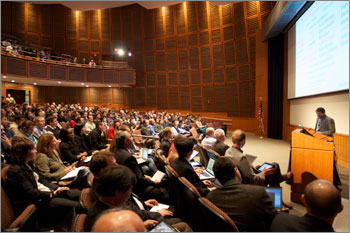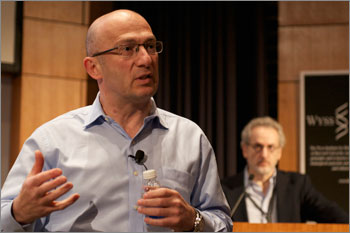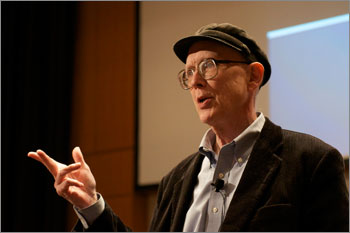International Audience Convenes to Hear from World's Leading Experts
The second annual Wyss Institute symposium drew a full-capacity crowd of academics, government representatives, and members of industry to hear some of the world’s leading experts in microfluidics share their insights into the exciting advances — and formidable commercialization challenges — now taking place in this rapidly evolving field.

The May 9 event, Microfluidics and Medicine: Accelerating the flow from lab to clinic, took place in the heart of Boston’s Longwood Medical Area. Approximately 400 people attended from across the United States, Canada, Europe, and Asia.
“This isn’t your typical scientific meeting,” said Wyss Institute Founding Director and Harvard Professor, Don Ingber, in addressing symposium attendees. “The reason we are all here is that we realize microfluidics has the potential to do complicated things very simply and cheaply, and we want to focus on the ways in which that potential can be realized in order to have an impact on people’s lives.”
Microfluidics combines microfabrication, engineering, chemistry, and physics to design systems in which the behavior and manipulation of fluids are precisely controlled at the micro scale. The same technology can be applied to culture and manipulate living cells under controlled conditions. Medical devices based on microfluidics have the potential to revolutionize many aspects of healthcare, including bringing reliable and cheap point-of-care diagnostics to a wide population. Microfluidics is also a key element in new organ-on-chip technologies, whose ability to accurately and immediately test new drugs for safety and efficacy could enable effective new treatments to reach the market faster than ever before.

The symposium featured a series of in-depth presentations covering a wide range of advances in microfluidics that are accelerating development of medical technologies in areas ranging from diagnostics and therapeutics to high-throughput screening technologies. It was distinctive in its ability to assemble so many leading experts from a single field under one roof.
Ingber, for instance, presented his novel technology for a human breathing lung-on-a-chip, which offers a new approach to evaluate the efficacy and toxicity of aerosolized drugs and nanoparticles, while Wyss Associate Faculty Member and Harvard Professor David Weitz highlighted his own work in ultra-high-throughput screening. His microdroplet- based technology allows for the low-cost, rapid development of large numbers of ultra-small bioreactors for evaluating the effects of drugs on materials and cells. This technology could one day revolutionize screening in the pharmaceutical industry.
Wyss Core Faculty Member and Harvard Professor, George Whitesides, chaired a session on advanced technologies in which Stephen Quake of Stanford University described his large-scale microfluidic integration as the biological equivalent of an integrated circuit, which he has applied to biological measurement and analysis. In the same session, Rustem Ismagilov of the University of Chicago showcased his elegantly simple “SlipChip,” which can perform multiplexed, microfluidic reactions without the need for pumps or valves, making it ideal for conducting experiments, such as diagnostics and evaluation of food, water, and air quality, in low resource settings.

Rather than focus exclusively on the technological advances, the symposium also dove into the myriad issues related to translating these discoveries into real-world solutions.
Darren Link, Co-Founder of RainDance Technologies, shared his experiences in developing a company that provides innovative droplet-based microfluidic solutions that accelerate human health and disease research. And Harp Minhas, Managing Editor of several peer-reviewed journals including Lab on a Chip, talked about obstacles and successes in technology translation.
Una Ryan, CEO of Diagnostics for All, whose mission it is to get low-cost diagnostics into the hands of people in the developing world, spearheaded this discussion during a round-table on commercialization challenges and lessons learned.
“The big hurdles at the end of the journey are the most expensive and the most difficult,” she told conference participants. “But if we don’t get these (discoveries) to the people who need them, then it’s all for naught.”
George Whitesides closed the meeting by offering his own perspective on what the future holds for the field, pointing out the enormous opportunities for impact in the pharmaceutical industry as well as many non-medical areas, such as energy, especially if researchers keep their eyes on the practical aspects, such as production of low-cost systems that can be distributed widely.
The Wyss Institute, which works as an alliance among Harvard and other leading clinical, academic, and industrial partners, emulates Nature’s principles to develop innovative new engineering solutions for healthcare, energy, architecture, robotics, and manufacturing. A key focus of the Institute is the translation of these discoveries into commercial products and therapies.